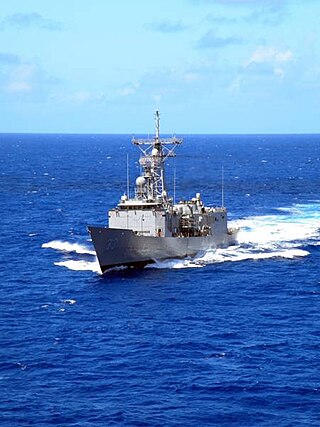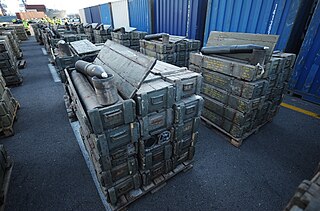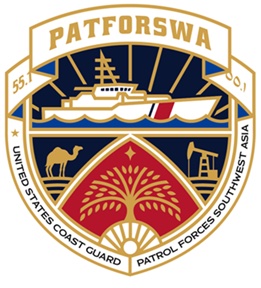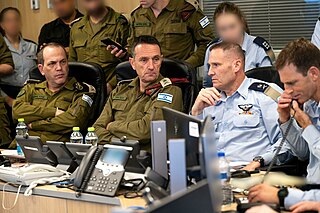
USS Cape St. George (CG-71) is a Ticonderoga-class cruiser laid down by the Litton-Ingalls Shipbuilding Corporation at Pascagoula, Mississippi, on 19 November 1990, launched on 10 January 1992, and commissioned on 12 June 1993. Cape St. George operates out of San Diego, California, and administratively reports to the Commander, Naval Surface Forces Pacific.

The Charles F. Adams class is a ship class of 29 guided-missile destroyers (DDG) built between 1958 and 1967. Twenty-three were built for the United States Navy, three for the Royal Australian Navy, and three for the West German Bundesmarine. The design of these ships was based on that of Forrest Sherman-class destroyers, but the Charles F. Adams class were the first class designed to serve as guided-missile destroyers. 19 feet (5.8 m) of length was added to the center of the design of the Forrest Sherman class to carry the ASROC launcher. The Charles F. Adams-class were the last steam turbine-powered destroyers built for the U.S. Navy. Starting with the succeeding Spruance-class, all U.S. Navy destroyers have been powered by gas turbines. Some of the U.S. Charles F. Adams class served during the blockade of Cuba in 1962 and during the Vietnam War; those of the Royal Australian Navy served during the Vietnam War and Gulf War.

USS Jarrett (FFG-33), was the twenty-fifth ship of the Oliver Hazard Perry-class guided missile frigates, was named for Vice Admiral Harry B. Jarrett (1898–1974).

USS Samuel B. Roberts (FFG-58) is one of the final ships in the United States Navy's Oliver Hazard Perry-class of guided missile frigates (FFG). Commissioned in 1986, the ship was severely damaged by an Iranian mine in 1988, leading U.S. forces to respond with Operation Praying Mantis. Repaired and returned to duty, the ship served until decommissioned in 2015.

USS Normandy (CG-60) is a Ticonderoga-class guided-missile cruiser in the service of the United States Navy. Armed with naval guns and anti-air, anti-surface, and anti-submarine missiles, plus other weapons, she is equipped for surface-to-air, surface-to-surface, and anti-submarine warfare. The cruiser was the first US warship since 1945 to go to war on her maiden cruise, and in 1998 was awarded the title "Most Tomahawks shot by a U.S. Navy Cruiser". She is named for the World War II Battle of Normandy, which took place in France on, and following, D-Day.

USS James E. Williams (DDG-95) is a Flight IIA Arleigh Burke-class destroyer in the United States Navy. The ship was named for Boatswain's mate Petty officer first class James Eliott Williams (1930–1999), a River Patrol Boat commander and Medal of Honor recipient from the Vietnam War who is considered to be the most decorated enlisted man in Navy history. As of April 2023 the ship is part of Destroyer Squadron 26 based out of Naval Station Norfolk.

USS Forrest Sherman (DDG-98) is an Arleigh Burke-class guided missile destroyer in the United States Navy and is the second US Navy ship to bear the name. She is part of Destroyer Squadron 28.

USS Gary (FFG-51) was an Oliver Hazard Perry-class frigate in the United States Navy. She was named for Medal of Honor recipient Commander Donald A. Gary (1903–1977).

The HESA Ababil is an Iranian family of single-engine multirole tactical unmanned aerial vehicles manufactured by Iran Aircraft Manufacturing Industrial Company (HESA). The Ababil comes in four main lines, the Ababil-2 ,3, 4 and 5, of which the Ababil-2 has a number of variants. It is considered a long-range, low-technology drone.

The Iranian Armed Forces, officially the Islamic Republic of Iran Armed Forces, are the combined military forces of Iran, comprising the Islamic Republic of Iran Army (Artesh), the Islamic Revolutionary Guard Corps (Sepah) and the Law Enforcement Force (Faraja).

The Francop Affair was a high seas incident on November 4, 2009 in which the Israeli Navy seized the cargo ship MV Francop in the eastern Mediterranean Sea and its cargo of hundreds of tons of weapons allegedly bound from Iran to Hezbollah. The incident is also known by its military operation name, Operation Four Species.

Patrol Forces Southwest Asia (PATFORSWA) is a United States Coast Guard command based in Manama, Bahrain. PATFORSWA was created in November 2002 as a contingency operation to support the U.S. Navy with patrol boats. The command's mission is to train, equip, deploy, and support combat-ready Coast Guard forces conducting operations in support of Operation Iraqi Freedom (OIF), Operation Enduring Freedom (OEF), Operation Inherent Resolve (OIR) in the Naval Forces Central Command's area of responsibility. It was commissioned as a permanent duty station in June 2004. In July 2003, PATFORSWA moved from its own compound to facilities at Naval Support Activity Bahrain.

The Iran–Israel proxy conflict, also known as the Iran–Israel proxy war or Iran–Israel Cold War, is an ongoing proxy conflict between Iran and Israel. In the Israeli–Lebanese conflict, Iran has supported Lebanese Shia militias, most notably Hezbollah. In the Israeli-Palestinian conflict, Iran has backed Palestinian groups such as Hamas. Israel has supported Iranian rebels, such as the People's Mujahedin of Iran, conducted airstrikes against Iranian allies in Syria and assassinated Iranian nuclear scientists. In 2018 Israeli forces directly attacked Iranian forces in Syria.

The Qods Yasir, also known as the Sayed-2, is an Iranian light tactical surveillance and reconnaissance unmanned aerial vehicle (UAV) manufactured by Qods Aviation. It is ostensibly an unlicensed copy of an American Boeing Insitu ScanEagle drone captured and reverse-engineered by Iran, but has some design changes.

A loitering munition, also known as a suicide drone, kamikaze drone, or exploding drone, is a kind of aerial weapon with a built-in warhead that is typically designed to loiter around a target area until a target is located, then attack the target by crashing into it. Loitering munitions enable faster reaction times against hidden targets that emerge for short periods without placing high-value platforms near the target area and also allow more selective targeting as the attack can be changed mid-flight or aborted.
The Iran–Israel conflict during the Syrian civil war refers to the Iranian–Israeli standoff in and around Syria during the Syrian conflict. With increasing Iranian involvement in Syria from 2011 onwards, the conflict shifted from a proxy war into a direct confrontation by early 2018.

The HESA Shahed 136, also known by its Russian designation Geran-2, is an Iranian-designed loitering munition, also referred to as a kamikaze drone or suicide drone, in the form of an autonomous pusher-propelled drone. It is designed and manufactured by the Iranian state-owned corporation HESA in association with Shahed Aviation Industries.
Events in the year 2023 in Yemen.

In 2024, the Iran–Israel proxy conflict escalated to a direct conflict between the two countries. On 1 April, Israel bombed the Iranian consulate in Damascus, killing multiple senior Iranian officials. In response, Iran and its proxies launched strikes inside Israel on 13 April.
















